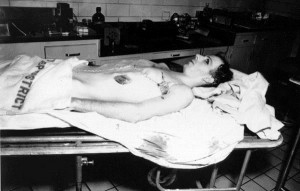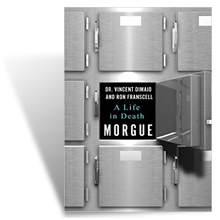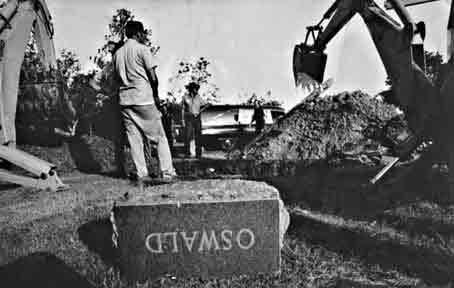
Dr. Vincent di Maio
Sixty years ago today, JFK assassin Lee Harvey Oswald was gunned down by Jack Ruby in Dallas. Here’s an excerpt from my Edgar-nominated true crime MORGUE: A LIFE IN DEATH, which explores the most historic, infamous, and heartbreaking cases of renowned medical examiner Dr. Vincent Di Maio. In this “clear, gritty, and enthralling narrative,” Dr. Di Maio and I guided the reader into the inner sanctum, behind the morgue door, to tell his fascinating life story through the cases that have made him famous, from Lee Harvey Oswald to Trayvon Martin, Phil Spector to Vincent van Gogh. MORGUE is available at Amazon.com.
Before the sun rose on October 4, 1981, we stood at the killer’s open grave. On that unseasonably muggy morning, we dug up Lee Harvey Oswald—or somebody—just to be sure America had buried the right man in 1963.
Ironically, almost nobody paid any attention when Oswald went into the ground, and now a crowd of reporters clustered outside the cemetery gates and a half dozen news helicopters swarmed overhead like corpse flies as we lifted him out.
To be sure, there hadn’t been much doubt at the time. Oswald’s corpse had been fingerprinted in the mortuary, and authorities were convinced that the twenty-four-year-old ex-Marine who defected to the USSR from 1959 to 1962, the laborer who worked in the Texas Schoolbook Depository, the shooter whose palm print had been found on the suspected murder rifle and boxes near the sniper’s perch, the feisty fugitive who had been arrested at the Texas Theater, and the suspect mortally wounded by Jack Ruby, were all the same man: Lee Harvey Oswald.

Was the real Oswald autopsied in 1963?
And, almost eighteen years later, I wasn’t expecting any surprises either. Forensically, I’d always been ambivalent about JFK’s assassination. It was an uncomplicated gunshot case that had gotten tangled up in a thousand different agendas. As with so many historic and newsworthy cases before and since, people quickly came to believe what they wanted to believe, damn the facts. I had been initially reluctant to join this exhumation team, knowing that our findings would just be fed into the conspiracy meat-grinder. Any questions we might answer would only spawn new questions.
Second autopsies like this are often a waste of time. Too often, they’re not prompted by new evidence, but by profit, curiosity, and urban legend. A second autopsy on President Kennedy might have definitively answered questions that went unanswered in his unskillful first, but digging up Oswald to satisfy a widow’s discomfort with media speculation made little medical or legal sense.
And it wasn’t rocket science. Any forensic pathologist—and maybe even a couple of backwoods coroners—could have done it. This promised to be a simple task I’d done thousands of times: identify a dead man. We had sufficient U.S. Marine Corps’ dental X-rays and other medical records to help us prove, one way or another, if Lee Harvey Oswald was buried in Lee Harvey Oswald’s grave.
But history sucked me in. The simplicity of the challenge was trumped by the significance of this dead killer’s role in human events. In the end, I couldn’t resist taking one last look at a man who changed the course of history—no matter who he might be.
The actual exhumation took much longer than expected.
We had planned to simply lift the entire 2,700-pound, steel-reinforced vault out of the grave and open it elsewhere, but the vault—guaranteed to last forever, they said—had cracked, allowing water to seep in. The rotting casket inside had grown brittle and was splotched with stains and mildew. Its metal handles were badly corroded. Part of the lid over the cadaver’s upper body had already caved in and we glimpsed, at the very least, that Lee Harvey Oswald’s grave wasn’t empty.
The decaying lid of Oswald’s casket, likely damaged when gravediggers removed the cracked vault, came completely loose in our hands as we opened it. The smell of moldy dirt, mildewed wood, and rotten flesh emanated from the box in an invisible cloud. The forensic pathologists in the room couldn’t ignore it; the civilians pulled back and covered their noses.
The casket’s interior was a mess. The inch-thick wooden sides were water-stained and spongy. Some of the moldy fabric lining had fallen loose from the lid, covering the corpse underneath. We gingerly removed the fabric remnants and there he was, lying on a rotten straw mat.
We were finally face to face with what was left of the man buried in Lee Harvey Oswald’s grave, or at least what appeared to be a man-shaped blob of black cream cheese in a cheap brown suit.
He wore no shoes and his feet had partially skeletonized. The muscles in his legs were long gone and a flimsy parchment of skin had shriveled around his dry bones.
His hands, also skeletal, were crossed politely over his belly in a classic funereal pose. On his left pinky, two rings stood out amid the grim, fetid decay: a gold wedding band and a smaller ring with a red gem, which Marina confirmed she had asked the funeral home to put on her late husband’s hand back in 1963. His face was unidentifiable.
Now, the dirty work began. We only needed his head.

